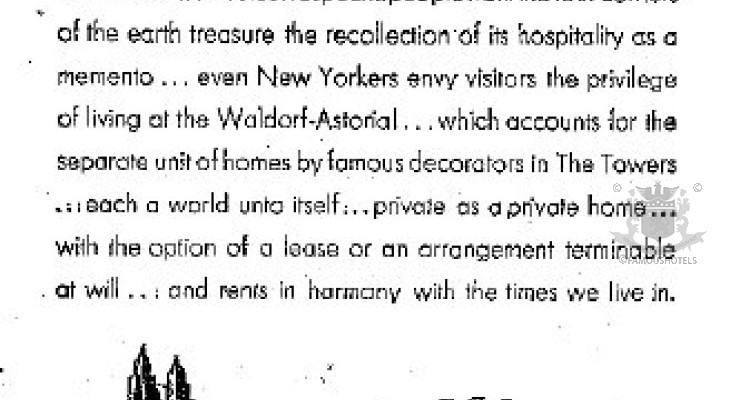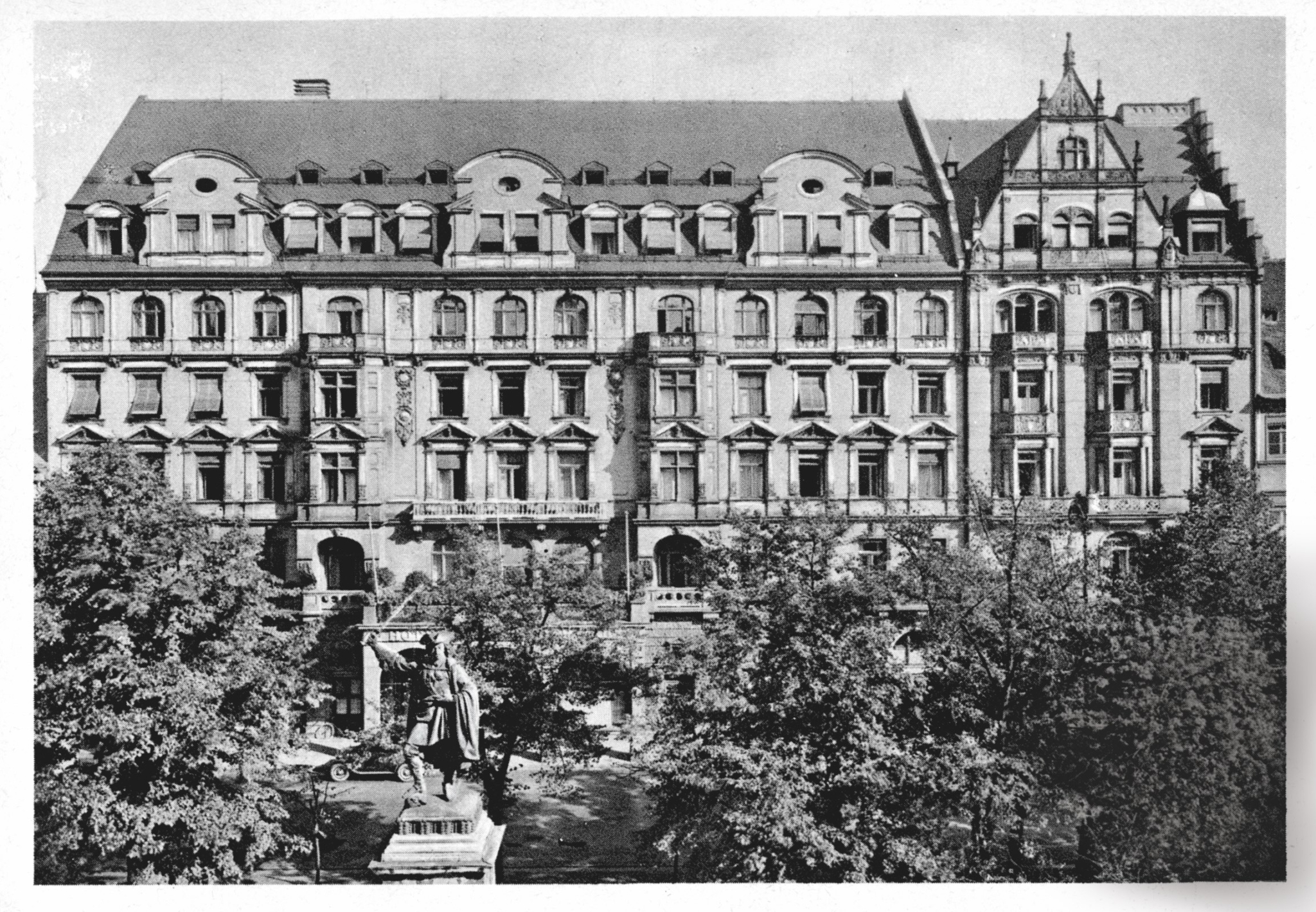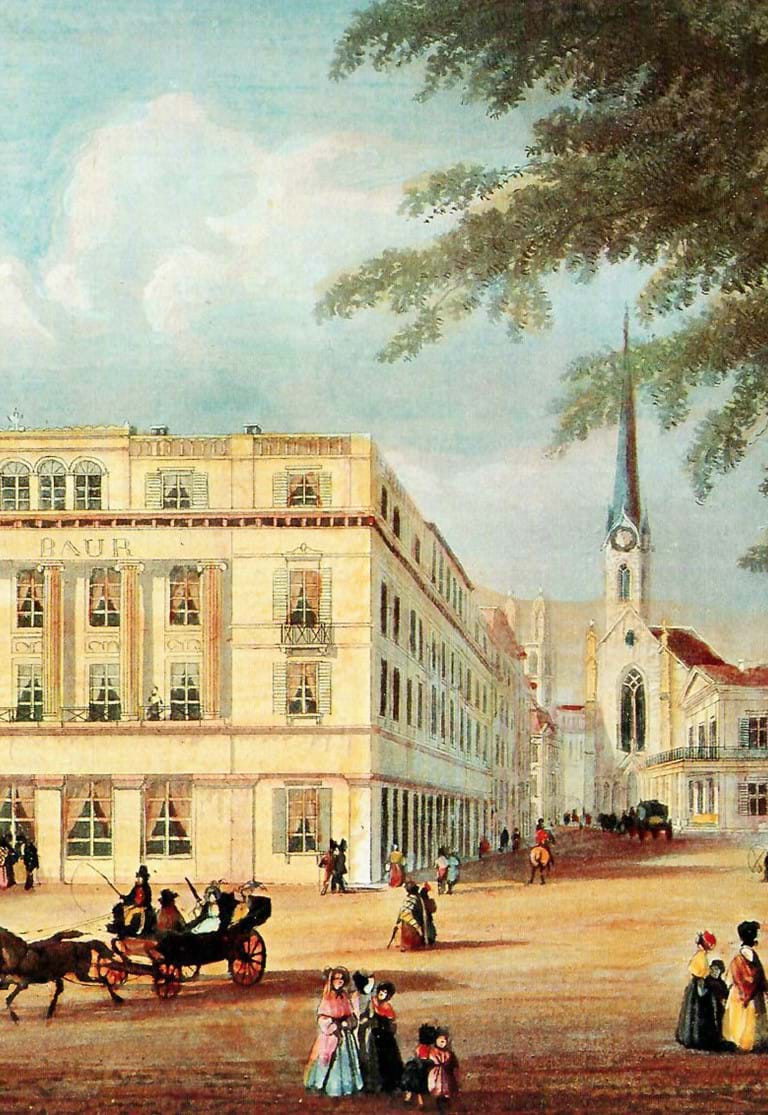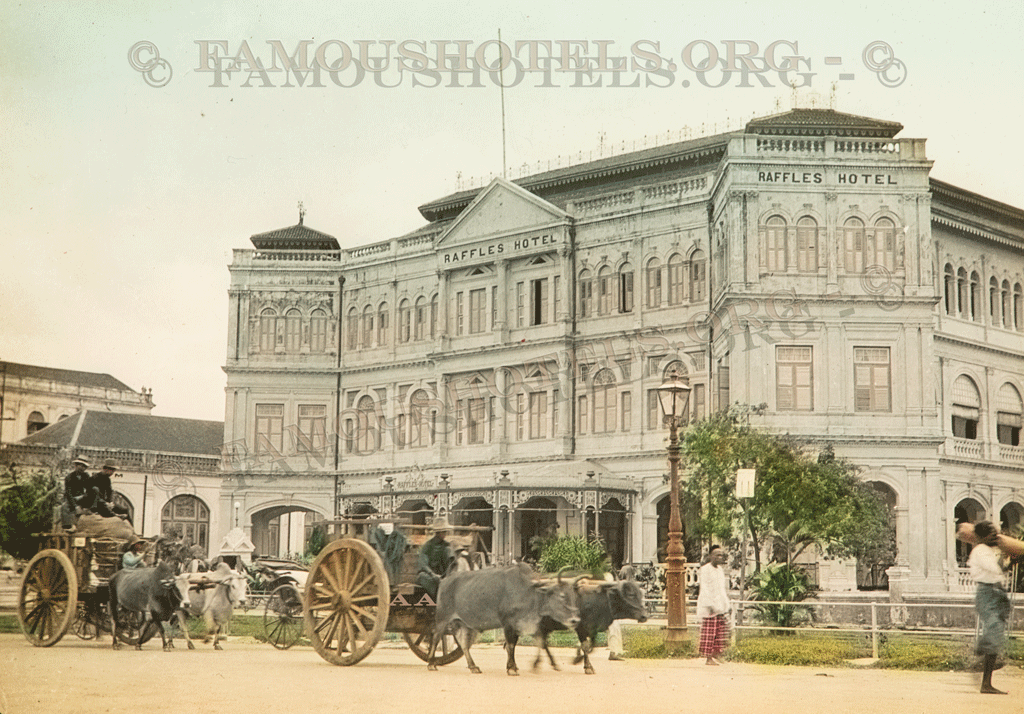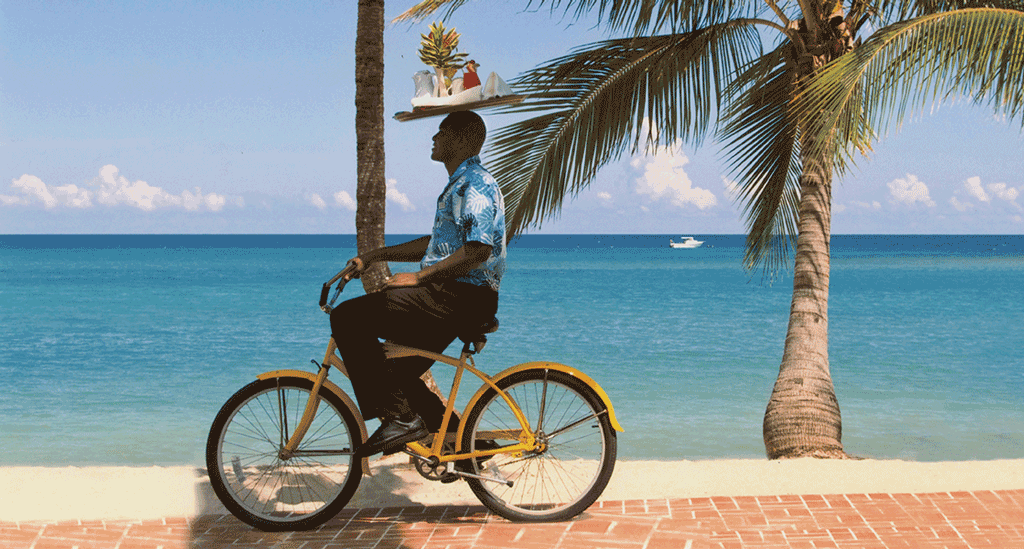1893: Making The Waldorf
( words)
New York Wanders Uptown (Originally Published 1931) It was the year of the World's Fair at Chicago and the year of the great panic. A nation was proudly proclaiming its industrial and artistic achievements and at the same time was writhing in an economic depression felt in every community and in every home. Aristocrats from Europe came to see the Chicago show and to scatter social largesse to the favored and thrilled few, while obscure individuals stood in long bread lines, waiting for their protesting appetites to be appeased. When men met in the streets, in clubhouses or at bars, they invariably spoke of these two contrasting conditions. Nothing else seemed to have much importance in the public mind. Yet in the midst of this there occurred an event that, for a time at least, overshadowed everything else, even the Fair and even the panic. It marked the dawn of a new social era in New York and, for that matter, in the United States, On March 13 the new Waldorf Hotel - the last word in grandeur and elegance - opened for business. And on the following night, while rain fell incessantly, dismally, upon the city, it had its first social debut, a formal concert. To that concert went the creme de la creme of New York, Boston and Philadelphia society. It was no casual event in New York's history. For with that night the old Waldorf was to revolutionize, not only the hotel standards of the time, but also a few of the customs and habits of the so-called Four Hundred. It was to inaugurate in America a new concept of grandeur in public places and, as Oliver Herford, the well known wit, said, it was to bring "exclusiveness to the masses." At the same time the Waldorf was to popularize among the wealthier and socially exclusive classes the art of "dining out." It was to become the gathering place of leaders of business and commerce. One of the greatest industrial organizations in the world was to be founded there. Men were to sit around tables or lean over desks and plan and dream of a new waterway that would pierce the Isthmus of Panama and connect the Atlantic and the Pacific. The special ambassador of a great world power, then engaged in war, was to hold forth in a suite at the hotel and pour out hundreds of cables in a determined and dramatic effort toward peace. Princes and princesses, presidents, famous generals all were to make it their temporary home. It was to be the stage for the picturesque Oscar, the forum for his epicurean philosophies, as well as the laboratory for his gastronomic theories. And this same hotel was even destined to become the battleground for a tremendous war on beards and mustaches! Yet the building in which all of these events centered has passed and a mightier skyscraper stands in its place, while in the newer residential district another` Waldorf-Astoria has reared its twin towers into the skyline. All this seems the more remarkable when one realizes that one hundred years ago the site of the original Waldorf building was a small field on one of the prettiest farms of Manhattan Island. A brook babbled across the property and an occasional wagon rumbled on the dusty Bloomingdale Road, or perhaps you might have seen a lonely horse and rider over on the old Middle Road in the vicinity of what now is Madison Avenue. Far to the south lay New York. A little while. before Indians had lighted their watch-fires and pitched their tepees on the site - then the white man came along. Thinking of the Astor homes, of the Waldorf-Astoria, of the new Empire State building it is difficult (even granting a concession to the comparative values of different ages) to believe that once the property had been purchased for only $2,400. That was what John Thomson had paid for the farm in 1799 when it was still an untilled tract of virgin land. It was described in the records as "that certain tract or piece of land formerly parcel of the common lands of the Mayor, Aldermen and Commonalty of the City of New York . . . released and conveyed to John Thomson by Indenture dated the 16th day of March, A.D. 1799." Researches made by David I. Bareuther, a New York Sun reporter, brought out some highly interesting information about the deal and the previous and subsequent history of the property. The Thomson farm comprised the six blocks now bounded by Broadway and Sixth Avenue on the west, Madison Avenue on the east and Thirty-third and Thirty-sixth Streets on the south and north. The land was intersected by Sunfish Creek. This rose in a spring in about Fifty-seventh Street, west of Broadway, and emptied into the Sun Fish Pond at the foot ofthe present Park Avenue. It was one of the many watercourses of Manhattan Island, now mysteriously lost. The stream approached the Waldorf property from a point in what now is Thirty-fourth Street, between the present Oppenheim Collins and Orkins stores. It was joined in the middle of the skyscraper site by another shorter brook which was fed by a spring. This junction of the two brooks formed a natural fishing hole. It was a place where many visitors to the farm went to catch sunfish and eels. Rich in historical associations was this farmland site of the Waldorf. Once a lively battle of the Revolutionary War took place there. In fact, Historian Albert Ullman claims that America came near to losing the Revolution within the Thirty-fourth Street district of Manhattan. That was when the British succeeded in landing their army at Kips Bay Farm, at the foot of Thirty-fourth Street on September 15, 1776, after the disastrous battle of Long Island. It was at this time that stray shots began to fall in the present Fifth Avenue in what became known as the "battle of the cornfield." Washington had rushed down from his headquarters in the Jumel mansion, which still stands in 160th Street. He took up his position on a knoll about where the New York Public Library stands today. His army was in rout, running toward him. There was every indication the British would break through, cross the Sunfish Creek and trap 3,500 troops still in the city at the tip of Manhattan Island. In the letters of his aide-de-camp it is told how Washington "laid his cane over many of the officers who shewed their men the example of running.,. Reinforced with more troops a rally was staged and General Putnam was sent down Sunfish Creek and Bloomingdale Road to rescue and direct the 3,500 men out of the city. The battle was fought on the famous Murray Farm, from which Murray Hill was named. In the Murray house, which stood in the bed of Park Avenue at Thirty-seventh Street, Mrs. Murray "saved the army." Deliberately she dined and wined the red-coated British officers so well that Putnam was able to slip past the Waldorf block with his army and join Washington in the retirement to Harlem Heights. The old Middle Road, which ran diagonally from Madison Avenue and Thirty-fourth Street to Fifth Avenue and Forty-second Street separated the John Thomson farm and the historic farm of Robert Murray. There is no record extant to show exactly where the Thomson house stood, but the chances are it occupied the Waldorf site, in order to be near the brook and spring. It must be remembered that fresh water was not only valuable, but scarce, in those days. The nearest rival to Sunfish Creek was a duck-pond, two blocks west on Henry Meig's six-acre farm. That was near the present corner of Thirty-fourth and Seventh Avenue, where the branch of the National City Bank and the, tall Nelson Tower stand today. Its large bull-frogs supplied the Henry Meigs's table with delectable frogs' legs when the French consul, Count d'Espinville, came to call. This was the condition of the neighborhood when William B. Astor bought the original Thomson farm. Records of the prices paid for that farm go back to the day Thomson purchased his "common lands." Ernest H. Wiener, who conducted an extensive research, however, was unable to find any record of Thomson's sale of the property. It is likely that he sold it, for a deed was recorded "at the request of W. C. Wetmore the 24th day of September, 1825, at 50 minutes past 3 P.M." This revealed that one Thomas Lawrence and Margaret, his wife, sold the same farm to Charles Lawton for $10,000. That property doubled its price in two years. Eventually the tract passed to William B. Astor for no less than $20,500 on July 28, 1827. That represented a hand-some rise in value. It was inconceivable that traders-could have visualized a day when the land would be worth $8,000,000 an acre - the rate paid for the old Waldorf-Astoria property in 1929, William B. Astor, like his father, the first John Jacob Astor, believed in holding on to New York real estate. The Astor family, like the Wendel family, steadfastly clung to the land. Indeed, old John Gottlieb Matthias Wendel and the first John Jacob Astor were partners and dabbled on a large scale in real estate. The difference between the two families, however, is obvious: the Wendels held to property without developing it; the Astors developed - and even sold - their land when to refuse to do so clashed with progress. They were progressive. William B. Astor, however, had to wait a long time before streets were cut through his property. Thirty-fourth Street didn't exist until 1836. It was staked right through to the Hudson River. Near the end of the street in that year a cornerstone was being laid for the new building of the New York Institute for the Blind. The asylum had chosen a splendidly "remote" location at a point now in Ninth Avenue, but then a part of the old Glass House Farm overlooking the Hudson River and the green Jersey shores. The end of Thirty-fourth Street was a quiet lane known as Hudson Place, and it is interesting to note that this is now a "walk-to-work" apartment colony. Astor's main concern, meanwhile, was the advance of the residential and business areas uptown. Although he himself lived in Lafayette Place, where Philip Hone writes in his diary of frequently dining with him, he had faith that the Waldorf site property would change from farm land to city suburbs, at least. It was a daring prophecy in that day. Even as late as 185o Fifth Avenue near Thirty-fourth Street was only an outlying country road. Reporter Bareuther tells us that the city directory of that year enumerated the houses only as far north as Twenty-third Street and stopped. "Beyond Twenty-third Street in 185o the avenue," says Valentine's Manual (Brown), "while cut through, was as yet unpaved and the sides fell off perceptibly from the street level." It was in this area that the first attempt at "skyscraping" was made. In Thirty-third Street, on part of the Pennsylvania Station site, flimsy wooden buildings prompted the erection of a fire tower. It was 100 feet high on iron columns. A circular iron stairway led up to a large bell and observation platform. Standing on this platform, the New Yorker of 1851 could see the city to the south and the great farms to the north. But the first big skyscraper - the wooden-framed Latting Observatory - was built in 1853 near where Stern's store stands in Forty-second Street. It was all of 350 feet high (a fantastic thing for that date) but it was a failure for the simple reason that few people dared to go up in its steam elevator. In 1856 it caught fire and at the same time wrecked the Crystal Palace across the street on the site of Bryant Park, causing one of the most spectacular fire scenes in the city's history. In 1859 one of the newspapers reported that: "A mansion, presenting a rather unique appearance, has been erected by John Jacob Astor, Jr., on the Fifth Avenue at the corner of Thirty-third Street. It is faced with Philadelphia pressed brick, and the window dressings, architraves, cornices, rustic columns, and stoop are made of Nova Scotia freestone." This was the first of the "twin" Astor houses. Then, a little later, came the William B. Astor home. New York was beginning at last to move up into the old farm lands.
